Interesting facts about the European drone regulation
In recent years, interest in drones and the number of privately owned drones has increased significantly. In order to ensure operational safety, the European aviation authority EASA (European Aviation Safety Agency) created a binding set of rules for the ownership and use of drones, the since 2021 must be complied with in all EU countries. In addition to the unified EU Drone Regulation However, there are still country-specific regulations that must be observed when operating drones. This is particularly important when traveling abroad. If you want to buy a drone, you should find out about all applicable laws and framework conditions and clarify all questions beforehand.
Compulsory insurance for drones
In principle, one applies in Germany, regardless of the size and weight or the type of use of the drone Compulsory liability insurance resulting from the operation of aircraft. This also applies to drones with very low weight and even so-called toy drones. In some cases it is worth a special drone insurance to complete. This also pays, for example, in the event of damage through no fault of your own, such as gusts of wind. However, it is not always necessary to take out your own policy– for example, if your private liability insurance already covers such damage.
The different drone classes at a glance
Drones are divided into different classes. The total seven classes take this into account, among other things drone weight and the kinetic energy . The requirements depend on the operational risk of the drone model. The seven drone classes are identified by the abbreviations C0 to C7 named, with the requirements increasing with each higher class. The easiest way to get an overview of the classification is based on the drone weight. That is always crucial take-off weight , i.e. the weight of the drone plus the battery and other attachments. If the drone has a camera, this must also be included in the take-off weight. For example, large and heavy drones must not be flown directly over crowds of people. But there are also limitations for small drone models, especially if the drone is equipped with a camera equipped is.
C0is the entry level for drones below 250 grams starting weight . C1 is the next higher class of drones and includes aircraft with a maximum starting weight from 900 grams or one kinetic energy of a maximum of 80 joules. The latter is mainly for small but fast racing drones relevant. The other classes differ as follows: C2 for Starting weights between 900 grams and 4 kilograms , followed by the classes C3 and C4 for aircraft with Starting weights between 4 and 25 kilograms . The remaining drone classes, consisting of C5, C6 and C7 , are intended for professional use and are subject to similar limitations as manned aviation. They therefore require a special operating permit or certification from the responsible authorities.

Do I have to register myself and my drone
The regulations and obligations for registering operators and drones are quite simple. The pan-European Registration obligation for drone operators always takes effect when that Takeoff weight over 250 grams lies or the kinetic energy of 80 joules is exceeded. So that includes all drones above the class C0 . Exceptions only apply to drones that are subject to the EU toy directive. In addition, regardless of the drone class, the operator must register whenever „Sensors for collecting personal data“ available. In the case of drones, these are mostly Cameras, but also microphones meet this condition. To do this, you need to register as an operator in the country where your primary residence have reported. You will then receive a personal registration number , which must be attached to all drones. Becomes a remote identification system used, the number must be stored there. The drone itself, on the other hand, only has to be registered if it falls into a category that requires approval.
When do I need an EU drone license or EU proof of competence?
Similar to the regulations for registration, there is a drone class C0 no obligation to complete one EU drone license respectively EU proof of competence, who also as small drone license referred to as. However, if you use drones from drone classes above C0 want to operate, you must have one EU drone license respectively EU proof of competence show. This is a compact one Online training followed by a test and an online exam . This is to ensure that the drone pilot has the necessary basic knowledge to be able to safely control a drone. You can easily apply for and complete the training and the exam online from an appropriate provider. The drone license is then valid in all EU countries and with one term of five years .
Responsible drone flying
In addition to those described above EU directives there is also national regulations and other specific regulations that depend on, for example, the distance to other people or the range of vision of the drones when flying. Also pay special attention Airspace Restrictions , such as near airports. These often also apply in the wider area. Violations of these regulations can be very expensive and ultimately endanger human life. It is therefore best to find out what applies to the respective drone and the location before using the drone. If you take all these points into account, nothing stands in the way of launching your drone. We wish you a lot of fun!




Leave a comment
This site is protected by hCaptcha and the hCaptcha Privacy Policy and Terms of Service apply.